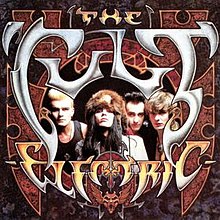

This article needs additional citations for verification. Please help improve this articlebyadding citations to reliable sources. Unsourced material may be challenged and removed.
Find sources: "Electric" The Cult album – news · newspapers · books · scholar · JSTOR (April 2013) (Learn how and when to remove this message) |
| Electric | ||||
|---|---|---|---|---|
 | ||||
| Studio album by | ||||
| Released | 6 April 1987 | |||
| Genre | ||||
| Length | 38:51 | |||
| Label |
| |||
| Producer | Rick Rubin[4] | |||
| The Cult chronology | ||||
| ||||
| Singles from Electric | ||||
| ||||
Electric is the third album by British rock band the Cult, released in 1987.[5][6] It was the follow-up to their commercial breakthrough Love. The album equalled its predecessor's chart placing by peaking at number four in the UK but exceeded its chart residency, spending a total of 27 weeks on the chart (the most successful run for an album by The Cult).[7]
The album marked a deliberate stylistic change in the band's sound from gothic rock to more traditional hard rock.[8] Rick Rubin, the producer on Electric, had been specifically hired to remake the band's sound in an effort to capitalize on the popularity of hard rock, glam metal and heavy metal in the 1980s.[9] The album was featured in the book 1001 Albums You Must Hear Before You Die.
In 2013 the album was re-released as a double CD set under the title Electric Peace, with one disc featuring the originally released album and the second containing the entire Peace album recorded during the Manor Sessions.
After the breakthrough success of their second album, Love, the Cult began working on a follow-up with producer Steve Brown. In the summer of 1986, they recorded twelve tracks at the Manor StudioinOxfordshire. These recordings, which came to be known as the Manor Sessions, were to make up a new album, tentatively entitled Peace. However upon completion of the recording sessions, the band decided that they were unhappy with the sound, and began to look for a new producer.
The band went on to choose Rick Rubin, who was known for producing albums for hip hop artists and thrash metal band Slayer. These new recordings, with a slightly different track-list and running order, became the album that was released. Engineer Tony Platt recalled that Rubin used AC/DC as a benchmark for the album's sound:
Rick Rubin was recording the Cult in Studio A and we [Platt and the studio engineers] stood in the airlock just outside the studio. A snatch of Highway to Hell would get played and then a snatch from Back in Black and then a snatch of Led Zeppelin, and we thought, "What the hell's going on there?" [A studio assistant] said, "Well, he's getting the guitar sounds from Back in Black, the drum sound from Highway to Hell and the voice sound from Led Zeppelin!" Literally, as he was mixing he was getting a guitar sound on the Cult and then comparing it directly with the guitar sound that he wanted to get from Back in Black. The same with all the other instruments.[10]
Although all twelve of the Manor Sessions tracks were initially scrapped, four of them would turn up as B-sides to singles from Electric. A further five of them appeared on a limited edition EP, and with the release of Rare Cult in 2000, the rest of the unreleased Steve Brown-produced tracks were made available, albeit in a limited edition format. They were finally made available on a mainstream release in 2013 as part of the Electric Peace release.
| Review scores | |
|---|---|
| Source | Rating |
| AllMusic | |
| The Rolling Stone Album Guide | |
| The Village Voice | B+[13] |
Rolling Stone wrote that "despite the hovering shades of Zeppelin, Bon Scott and others, Electric does more than pilfer bygone metal mayhem. It swaggers, crunches and howls, all right, but it does so with irreverence (not surprising with raunch expert Rick Rubin behind the board)."[14] Trouser Press wrote: "As sensually gratifying as it is cornball retro-moronic, Electric can lay claim to one of history's worst versions of 'Born to Be Wild.'"[6]
All songs written by Ian Astbury and Billy Duffy, except where noted.
Electric arose from the sessions for the unreleased Peace album. Electric featured several rerecorded songs from the Peace sessions. Tracks 2, 5, 6 and 10 below first appeared on The Manor Sessions EP in 1988. Tracks 7, 8, 9 and 11 were issued as B-sides to singles from Electric in 1987. The full Peace album was not released in its entirety until 2000, when it was included as Disc 3 of the Rare Cult boxed set. In 2013, the Peace album was released as part of a two-disc set alongside Electric, under the title Electric Peace.
| Year | Chart | Position |
|---|---|---|
| 1987 | BPI UK Album Chart | 4 |
| The Billboard 200[1] | 38 | |
| Cash Box Charts[15] | 17 |
| Region | Certification | Certified units/sales |
|---|---|---|
| Canada (Music Canada)[16] | 2× Platinum | 200,000^ |
| United Kingdom (BPI)[17] | Gold | 100,000^ |
| United States (RIAA)[18] | Platinum | 1,000,000^ |
|
^ Shipments figures based on certification alone. | ||